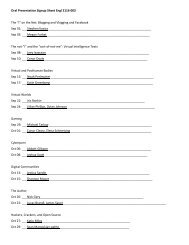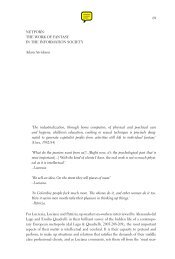Nakamura, Digitizing Race, Introduction, chapter 5, Epilogue
Nakamura, Digitizing Race, Introduction, chapter 5, Epilogue
Nakamura, Digitizing Race, Introduction, chapter 5, Epilogue
Create successful ePaper yourself
Turn your PDF publications into a flip-book with our unique Google optimized e-Paper software.
80 Alllooksame?<br />
the score; the average score is seven. Users are given the corrected version<br />
of their test so they can guess which ones they got “wrong,” and are told<br />
that they are “OK” if they get a score higher than average.<br />
Suematsu writes that he designed the site “ultimately as a joke” and that<br />
he “didn’t mean this site to be some sort of political arena.” Despite this, as<br />
he writes in an essay to the user, “Some people felt that this site would promote<br />
racism, or that the site itself is racist. Others felt quite the opposite. I<br />
was very surprised to receive many emails with encouraging words from<br />
Chinese, Korean, and Japanese people. In some ways, I was expecting to<br />
upset many of these people.” The wide range of responses to the site demonstrates<br />
the ways that this particular kind of interactivity, one that puts the<br />
user in the position of a racial profiler of sorts, functions as a nexus for<br />
Asians and Asian Americans to actively consider race as an act of seeing.<br />
The site’s bulletin board encourages active conversation about the meaning<br />
of the test and most importantly constitutes a valuable and unique opportunity<br />
to study the Asian American new media user. As Elizabeth Bird writes<br />
in her perceptive study of media audience ethnography in The Audience in<br />
Everyday Life, ethnicity and gender produce significant differentials in the<br />
qualitative research process that must be thought through more carefully. In<br />
her study of Native Americans and their media use, she noticed that group<br />
interviews worked well in gathering information because they used a “communicative<br />
style . . . more collaborative and less competitive than Anglos,”<br />
but she discovered that this was only the case among single-sex groups, since<br />
Native American females tended to defer to older males in group settings. 16<br />
Bird encourages a careful interrogation of what she calls the “ethnographic<br />
encounter” in a broad sense, taking note not only of the ethnographer’s<br />
own identity and its relation to the type of interaction she is likely to have<br />
with informants, but also whether the presence or absence of the researcher<br />
might foreclose or enable particular kinds of conversations. Asian Americans<br />
tend not to be especially forthcoming about themselves in non-anonymous<br />
or interview situations for several reasons: if they are undocumented immigrants,<br />
they may not wish to call attention to themselves, and many Asian<br />
cultures tend to frown on individuals speaking about personal matters or<br />
opinions in public settings. For these reasons, Asian Americans may post to<br />
the Internet in cases in which they might not confide in an interviewer. In<br />
addition, people who have noticeable foreign accents may be mocked or<br />
devalued as “FOB” (Fresh off the Boat) in settings that require spoken language,<br />
and the use of imperfect or nonstandard written English may also be<br />
a source of embarrassment to survey takers. It matters what type of Web site





